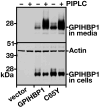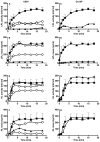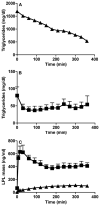Chylomicronemia with low postheparin lipoprotein lipase levels in the setting of GPIHBP1 defects
- PMID: 20124439
- PMCID: PMC2858258
- DOI: 10.1161/CIRCGENETICS.109.908905
Chylomicronemia with low postheparin lipoprotein lipase levels in the setting of GPIHBP1 defects
Abstract
Background: Recent studies in mice have established that an endothelial cell protein, glycosylphosphatidylinositol-anchored high-density lipoprotein-binding protein 1 (GPIHBP1), is essential for the lipolytic processing of triglyceride-rich lipoproteins.
Methods and results: We report the discovery of a homozygous missense mutation in GPIHBP1 in a young boy with severe chylomicronemia. The mutation, p.C65Y, replaces a conserved cysteine in the GPIHBP1 lymphocyte antigen 6 domain with a tyrosine and is predicted to perturb protein structure by interfering with the formation of a disulfide bond. Studies with transfected Chinese hamster ovary cells showed that GPIHBP1-C65Y reaches the cell surface but has lost the ability to bind lipoprotein lipase (LPL). When the GPIHBP1-C65Y homozygote was given an intravenous bolus of heparin, only trace amounts of LPL entered the plasma. We also observed very low levels of LPL in the postheparin plasma of a subject with chylomicronemia who was homozygous for a different GPIHBP1 mutation (p.Q115P). When the GPIHBP1-Q115P homozygote was given a 6-hour infusion of heparin, a significant amount of LPL appeared in the plasma, resulting in a fall in the plasma triglyceride levels from 1780 to 120 mg/dL.
Conclusions: We identified a novel GPIHBP1 missense mutation (p.C65Y) associated with defective LPL binding in a young boy with severe chylomicronemia. We also show that homozygosity for the C65Y or Q115P mutations is associated with low levels of LPL in the postheparin plasma, demonstrating that GPIHBP1 is important for plasma triglyceride metabolism in humans.
Figures








Similar articles
-
Chylomicronemia with a mutant GPIHBP1 (Q115P) that cannot bind lipoprotein lipase.Arterioscler Thromb Vasc Biol. 2009 Jun;29(6):956-62. doi: 10.1161/ATVBAHA.109.186577. Epub 2009 Mar 19. Arterioscler Thromb Vasc Biol. 2009. PMID: 19304573 Free PMC article.
-
Mutation of conserved cysteines in the Ly6 domain of GPIHBP1 in familial chylomicronemia.J Lipid Res. 2010 Jun;51(6):1535-45. doi: 10.1194/jlr.M002717. Epub 2009 Dec 21. J Lipid Res. 2010. PMID: 20026666 Free PMC article.
-
Mutations in lipoprotein lipase that block binding to the endothelial cell transporter GPIHBP1.Proc Natl Acad Sci U S A. 2011 May 10;108(19):7980-4. doi: 10.1073/pnas.1100992108. Epub 2011 Apr 25. Proc Natl Acad Sci U S A. 2011. PMID: 21518912 Free PMC article.
-
GPIHBP1, an endothelial cell transporter for lipoprotein lipase.J Lipid Res. 2011 Nov;52(11):1869-84. doi: 10.1194/jlr.R018689. Epub 2011 Aug 15. J Lipid Res. 2011. PMID: 21844202 Free PMC article. Review.
-
The GPIHBP1-LPL complex and its role in plasma triglyceride metabolism: Insights into chylomicronemia.Biomed Pharmacother. 2023 Dec 31;169:115874. doi: 10.1016/j.biopha.2023.115874. Epub 2023 Nov 9. Biomed Pharmacother. 2023. PMID: 37951027 Review.
Cited by
-
Identification of mutations underlying 20 inborn errors of metabolism in the United Arab Emirates population.Genet Test Mol Biomarkers. 2012 May;16(5):366-71. doi: 10.1089/gtmb.2011.0175. Epub 2011 Nov 22. Genet Test Mol Biomarkers. 2012. PMID: 22106832 Free PMC article.
-
Comparative studies of glycosylphosphatidylinositol-anchored high-density lipoprotein-binding protein 1: evidence for a eutherian mammalian origin for the GPIHBP1 gene from an LY6-like gene.3 Biotech. 2012 Mar;2(1):37-52. doi: 10.1007/s13205-011-0026-4. Epub 2011 Oct 18. 3 Biotech. 2012. PMID: 22582156 Free PMC article.
-
A homozygous variant in the GPIHBP1 gene in a child with severe hypertriglyceridemia and a systematic literature review.Front Genet. 2022 Aug 16;13:983283. doi: 10.3389/fgene.2022.983283. eCollection 2022. Front Genet. 2022. PMID: 36051701 Free PMC article.
-
Evidence for Two Distinct Binding Sites for Lipoprotein Lipase on Glycosylphosphatidylinositol-anchored High Density Lipoprotein-binding Protein 1 (GPIHBP1).J Biol Chem. 2015 May 29;290(22):13919-34. doi: 10.1074/jbc.M114.634626. Epub 2015 Apr 14. J Biol Chem. 2015. PMID: 25873395 Free PMC article.
-
Organization, evolution and functions of the human and mouse Ly6/uPAR family genes.Hum Genomics. 2016 Apr 21;10:10. doi: 10.1186/s40246-016-0074-2. Hum Genomics. 2016. PMID: 27098205 Free PMC article. Review.
References
-
- Wang H, Eckel RH. Lipoprotein Lipase: from gene to obesity. Am J Physiol Endocrinol Metab. 2009;297:E271–E288. - PubMed
-
- Beigneux AP, Davies BS, Gin P, Weinstein MM, Farber E, Qiao X, Peale F, Bunting S, Walzem RL, Wong JS, Blaner WS, Ding ZM, Melford K, Wongsiriroj N, Shu X, De Sauvage FJ, Ryan RO, Fong LG, Bensadoun A, Young SG. Glycosylphosphatidylinositol-anchored high-density lipoprotein-binding protein 1 plays a critical role in the lipolytic processing of chylomicrons. Cell Metab. 2007;5:279–291. - PMC - PubMed
Publication types
MeSH terms
Substances
Grants and funding
LinkOut - more resources
Full Text Sources
Other Literature Sources
Molecular Biology Databases
Research Materials

